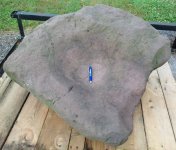OntarioArch
Sr. Member
I bought this artifact from a local Old Timer, who said it was discovered by a farmer friend while "clearing fields around 1900". Since it is so heavy (maybe 300 lbs...), I'm thinking the site of this discovery is also likely to be the site of a Native American settlement / camp of some sort: who wants to lug around a 300 pound stone?
I know the old farmstead on which it was reportedly discovered....took a tour by the friendly owner......but sorry to say it is 60 acres big, almost all hay fields. It does contain two 'springs' which were wet even during our July very dry spell. Nearby those springs are hay fields, only. No exposed soil.
Now....across the road, maybe 1/4 mile away on another landowner's property, lies a nice flat field, just above the high water mark of a substantial creek that flows all year. Could the farmer have also cleared this field? Could this field have been a part of the old homestead back in 1900? Don't cows need a good water supply?
As soon as the corn comes down this Fall.....I'll be walking it. Again, a very friendly owner much interested that his land might hold NA artifacts thousands of years old!

I know the old farmstead on which it was reportedly discovered....took a tour by the friendly owner......but sorry to say it is 60 acres big, almost all hay fields. It does contain two 'springs' which were wet even during our July very dry spell. Nearby those springs are hay fields, only. No exposed soil.
Now....across the road, maybe 1/4 mile away on another landowner's property, lies a nice flat field, just above the high water mark of a substantial creek that flows all year. Could the farmer have also cleared this field? Could this field have been a part of the old homestead back in 1900? Don't cows need a good water supply?
As soon as the corn comes down this Fall.....I'll be walking it. Again, a very friendly owner much interested that his land might hold NA artifacts thousands of years old!

Last edited:
Upvote
0





